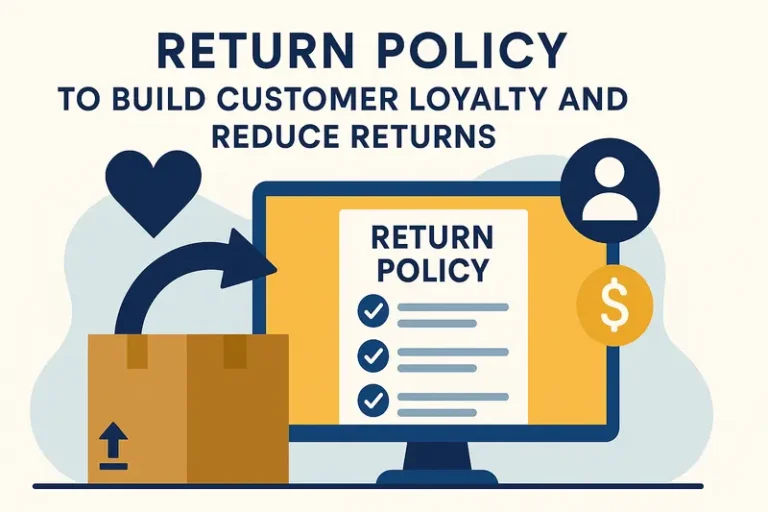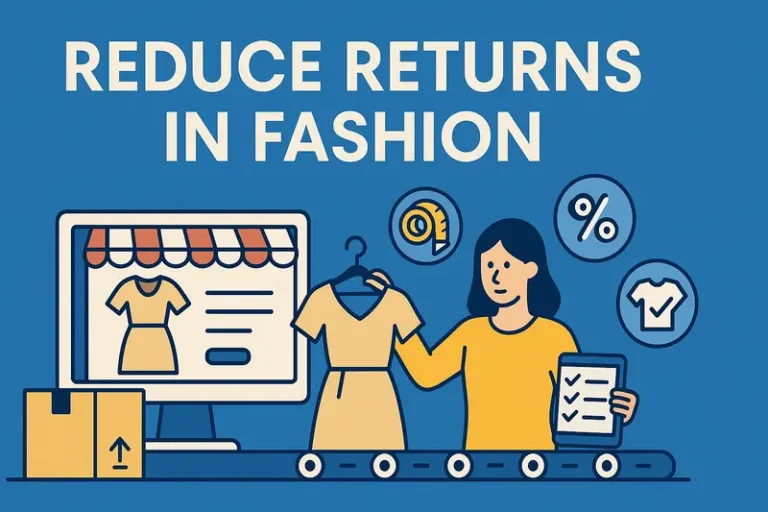Crafting a Return Policy in Ecommerce: A Customer-Friendly Approach That Doesn’t Hurt Profits

Last updated on April 28, 2025

In this article
 11 minutes
11 minutes
- Introduction to Return Policies
- Understanding the Importance of a Customer-Friendly Return Policy
- Key Components of a Customer-Friendly Return Policy
- Creating a Return Policy
- Return Policy Benefits
- Strategies for Reducing Returns Without Losing Customers
- Customer Service Team
- Summary
- Frequently Asked Questions
Having a well-structured and customer-friendly returns policy is essential for both retaining customers and maintaining profitability. Understanding the average ecommerce return rate, which often exceeds 20%, is crucial for financial planning and customer retention. Returns are a natural part of online shopping, but the way an ecommerce business manages its return process can greatly impact customer satisfaction, brand reputation, and ultimately profit margins.
The challenge lies in creating a return policy that meets customer expectations while keeping shipping costs and return shipping fees under control. A good return policy not only helps businesses retain loyal customers but can also be a powerful tool for customer acquisition, turning a potentially negative experience into an opportunity for repeat purchases.
This article will delve into the key components of a customer-friendly returns policy, how businesses can reduce the financial impact of returns, and actionable steps for ensuring a smooth and cost-effective return process. By the end, you’ll have the knowledge to craft a returns policy that enhances the customer experience without hurting your bottom line.
Introduction to Return Policies
A return policy is a necessary aspect of any ecommerce business, as it outlines the rules and procedures for customers to return or exchange purchased products. A well-crafted return policy can help build trust with customers, increase customer satisfaction, and ultimately drive sales revenue. In today’s competitive online market, customers expect a hassle-free return policy that meets their needs and exceeds their expectations. By offering a clear and customer-centric return policy, ecommerce businesses can differentiate themselves from competitors and establish a loyal customer base.
Make Returns Profitable, Yes!
Cut shipping and processing costs by 70% with our patented peer-to-peer returns solution. 4x faster than traditional returns.
See How It WorksUnderstanding the Importance of a Customer-Friendly Return Policy
The Role of Returns in Customer Satisfaction and Loyalty
An ecommerce return policy directly affects customer satisfaction and can significantly boost sales. It is often the final touchpoint in the customer journey, and how it is handled can make or break customer loyalty. A hassle-free return policy that allows customers to easily return products builds trust and increases the likelihood of repeat business.
While ecommerce stores strive to offer the best customer experience, an overly restrictive or complicated returns process can lead to customer complaints, negative reviews, and lost sales. Conversely, a customer-friendly return policy can turn a potentially negative situation into a positive one, creating long-term value for both the customer and the business.
Balancing Customer Expectations and Business Profitability
Many online retailers struggle with the challenge of offering a return policy that satisfies customers while still protecting profit margins. In today’s market, customers expect free returns, easy-to-understand policies, and a smooth return experience. However, offering free returns shipping and full refunds can significantly increase return shipping costs and operational expenses.
The goal is to design a return policy that meets customer expectations without compromising long-term revenue growth. A clear and fair refund policy is crucial for customer satisfaction and must comply with legal requirements. Understanding the factors that drive returns, such as size mismatches, product quality issues, and impulse buying, will help businesses tailor their policies to reduce return rates and mitigate associated costs.
Key Components of a Customer-Friendly Return Policy
A well-crafted return policy is transparent, easy to understand, and provides options that meet both customer needs and business goals. Here are the essential components of a customer-friendly returns policy that also helps protect your profit margins.
1. Clear and Transparent Return Guidelines
Customers appreciate clarity when it comes to return and refund policies. It is important to disclose refund and return policies in relation to the purchase date, as certain states, like California, have legal requirements for merchants to post their refund policies if they offer refunds, exchanges, or store credits within a specified timeframe after the purchase date. A return policy that’s buried in the fine print or hidden on a website’s FAQ page can lead to confusion and frustration. To avoid this, ensure your return policy is clearly communicated on your ecommerce website and easily accessible.
Outline the specifics of the return window, the condition in which products should be returned (e.g., original packaging and unused), and any exclusions (e.g., final sale items). Make it clear whether return shipping is included or if customers will have to pay for return shipping fees. This transparency helps manage customer expectations from the start.
2. Offering Multiple Return Options
Not all customers prefer the same return method. While some may prefer to send back an item through prepaid return shipping labels, others might want to return it directly to a brick-and-mortar store if available. Allowing customers to return in-store not only enhances customer satisfaction by providing flexibility but also offers potential upselling opportunities, as customers who return items often end up purchasing additional products. By offering multiple options, such as in-store returns, local drop-off points, or prepaid return shipping labels, you can provide a more convenient returns process that caters to a wider customer base.
Offering free return shipping for certain orders, such as for faulty items or returns made within a specific time frame, will reduce friction for customers and improve their overall shopping experience.
3. Setting a Reasonable Return Window
A reasonable return window strikes a balance between giving customers enough time to assess their purchases and ensuring that returns don’t drag on too long. During the holiday shopping season, ecommerce return rates can increase significantly, sometimes reaching as high as 30% or more, which impacts return policies and customer satisfaction. Many ecommerce businesses offer 30 days for returns, but this can vary depending on your industry and products. For example, products like electronics may require a shorter return period due to restocking fees and potential product depreciation.
Offering a return window that matches customer expectations while keeping inventory management in mind helps reduce returns that may occur after a long delay.
Convert Returns Into New Sales and Profits
Our peer-to-peer returns system instantly resells returned items—no warehouse processing, and get paid before you refund.
I'm Interested in Peer-to-Peer Returns4. Offering Store Credit Instead of Full Refunds
Instead of offering full refunds, consider handling exchange requests as opportunities for upselling or cross-selling. By offering store credit or exchanges, you can keep the value of the returned product within the business. This not only reduces lost revenue but also encourages repeat customers to return to your online store.
Store credit can be offered as a percentage of the original purchase price or as a credit equal to the value of the returned item. This solution can be especially effective during holiday shopping seasons, when sales are high and customers may be more willing to accept store credit rather than a refund.
What you can do: Offer store credit as a primary return option, providing incentives for customers to make future purchases rather than just returning items for a full refund.
5. Managing Return Fraud
Ecommerce return fraud is a growing issue that affects ecommerce businesses and can significantly impact profit margins. Customers returning stolen merchandise, used items, or products that have been altered can have a significant impact on profit margins. To combat return fraud, require proof of purchase and implement Return Merchandise Authorization (RMA) systems to ensure returned products meet the criteria set out in your policy.
You can also use return data to track customers who regularly return items, identify fraudulent ecommerce returns, and flag potential abuse.
Creating a Return Policy
Creating a return policy involves several key considerations, including the types of products that can be returned, the timeframe for returns, and the process for initiating a return. Ecommerce businesses must also decide whether to offer free return shipping, charge restocking fees, or offer store credit for returns. A return policy should be easy to understand, concise, and readily available on the ecommerce website. By providing a clear and comprehensive return policy, ecommerce businesses can manage customer returns effectively, reduce return shipping costs, and maintain a positive customer experience.
Return Policy Benefits
A well-crafted return policy can offer numerous benefits to ecommerce businesses, including increased customer loyalty, improved customer satisfaction, and reduced return rates. By offering a hassle-free return policy, ecommerce businesses can encourage customers to make purchases with confidence, knowing that they can easily return or exchange products if needed. Additionally, a clear return policy can help reduce customer complaints, improve customer retention, and drive long-term revenue growth. By prioritizing customer satisfaction and providing a customer-centric return policy, ecommerce businesses can establish a loyal customer base and stay competitive in the online market.
Strategies for Reducing Returns Without Losing Customers
While returns are inevitable, there are several strategies you can implement to reduce the number of customer returns without losing customer loyalty.
1. Provide Accurate Product Descriptions and High-Quality Images
Accurate product descriptions and high-quality images help set clear expectations for customers. Many customers purchase multiple versions of the same item, such as clothing in different sizes, which can impact return rates. Include detailed information such as size charts, materials, dimensions, and any other relevant details that will help customers make informed purchase decisions. Misleading product details lead to a higher rate of returns, as customers are likely to be disappointed when their purchase doesn’t match what they were expecting.
What you can do: Invest in high-quality photos, videos, and accurate descriptions to make sure customers know exactly what they’re purchasing. This reduces the likelihood of returns driven by misunderstanding.
2. Use Data to Understand Return Trends
By tracking return data, you can identify patterns in customer behavior and address issues that lead to returns. For example, if you notice that a particular product category, such as shoes, is frequently returned due to size issues, consider implementing virtual try-ons or improving size guides. This data-driven approach can help you optimize your return process and reduce return rates over time by effectively managing the process returns through a strategic return management system.
What you can do: Use returns management systems that allow you to track return data and identify trends. Adjust product offerings, descriptions, and sizing recommendations based on this information.
3. Offer Easy Exchanges
Rather than accepting returns for refunds, offer exchanges as the primary option. Offering free return shipping exclusively for exchanges can mitigate losses associated with refunds and maintain healthier cash flow. Allow customers to easily exchange items for the correct size, color, or model. This not only retains the product in your inventory but also keeps customers engaged with your brand.
What you can do: Make exchanges as easy as returns, with clear instructions and a seamless process. Store credit can also be offered as part of the exchange process.
No More Return Waste
Help the planet and your profits—our award-winning returns tech reduces landfill waste and recycles value. Real savings, No greenwashing!
Learn About Sustainable ReturnsCustomer Service Team
A customer service team plays a critical role in managing returns and ensuring a positive customer experience. Ecommerce businesses should train their customer service team to handle returns efficiently, respond to customer inquiries, and provide timely refunds or exchanges. By providing excellent customer service, ecommerce businesses can turn returns into opportunities to build customer loyalty and drive future sales. A well-trained customer service team can also help reduce return rates by addressing customer concerns, providing product information, and offering alternative solutions.
Summary
Crafting a customer-friendly return policy is crucial for both customer satisfaction and business profitability. By setting clear return guidelines, offering multiple return options, and providing alternatives to full refunds, businesses can reduce the costs associated with returns while maintaining customer loyalty.
Remember that an effective returns policy doesn’t just focus on minimizing return rates; it also plays a significant role in shaping the customer experience and building long-term relationships with your online shoppers. When executed thoughtfully, your return process can enhance customer loyalty, drive repeat purchases, and ultimately increase sales revenue without sacrificing your profit margins.
Frequently Asked Questions
What makes a return policy customer-friendly?
A customer-friendly return policy starts with the need to write a return policy that enhances customer satisfaction and trust. It should be clear, flexible, and easy to understand. It provides customers with options for returns and exchanges, includes a reasonable return window, and offers solutions like store credit instead of refunds.
How can offering store credit help reduce returns?
Offering store credit instead of a full refund helps retain revenue and encourages customers to make future purchases. It also reduces the loss of returned merchandise and can increase customer loyalty.
What are the costs associated with ecommerce returns?
The costs of ecommerce returns include shipping costs, restocking fees, and potential losses if returned items cannot be resold. Return fraud and reverse logistics processes also contribute to operational expenses.
How can I reduce return rates in ecommerce?
Reducing return rates involves improving product descriptions, offering accurate size guides, providing better customer service, and using data to optimize inventory management and understand customer behavior.
How can I handle return fraud in ecommerce?
To minimize return fraud, implement stricter return policies, require proof of purchase, and use return merchandise authorization (RMA) systems to ensure that returned items meet your policy’s criteria. Tracking return data can also help identify fraudulent patterns.

Turn Returns Into New Revenue





